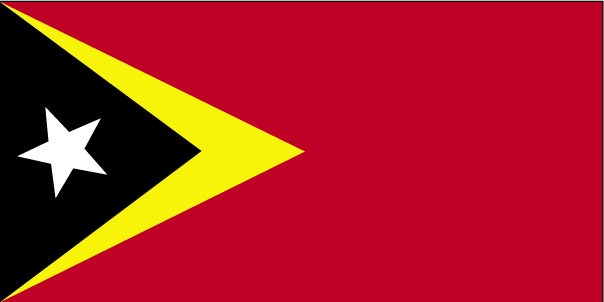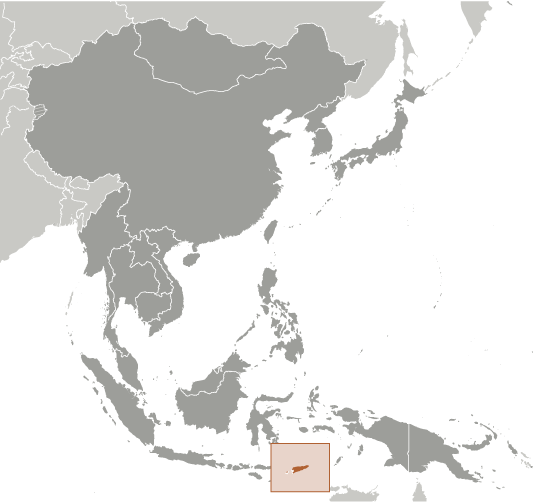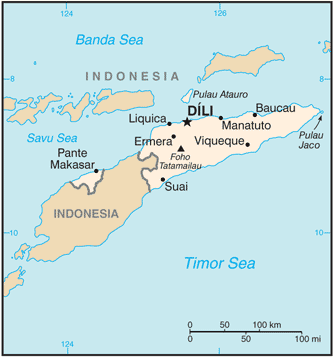|
Country name:
|

|
|
conventional long form: Democratic Republic of Timor-Leste (pronounced TEE-mor LESS-tay)
conventional short form:
Timor-Leste
local long form:
Republika Demokratika Timor Lorosa'e [Tetum]; Republica Democratica de Timor-Leste [Portuguese]
local short form:
Timor Lorosa'e [Tetum]; Timor-Leste [Portuguese]
former:
East Timor, Portuguese Timor
|
|
|
Government type:
|

|
|
republic
|
|
|
Capital:
|

|
|
name: Dili
geographic coordinates:
8 35 S, 125 36 E
time difference:
UTC+9 (14 hours ahead of Washington, DC during Standard Time)
|
|
|
Administrative divisions:
|

|
|
13 administrative districts; Aileu, Ainaro, Baucau, Bobonaro (Maliana), Cova-Lima (Suai), Dili, Ermera (Gleno), Lautem (Los Palos), Liquica, Manatuto, Manufahi (Same), Oecussi (Ambeno), Viqueque
note:
administrative divisions have the same names as their administrative centers (exceptions have the administrative center name following in parentheses)
|
|
|
Independence:
|

|
|
28 November 1975 (independence proclaimed from Portugal); note - 20 May 2002 is the official date of international recognition of Timor-Leste's independence
|
|
|
National holiday:
|

|
|
Proclamation of Independence Day, 28 November (1975)
|
|
|
Constitution:
|

|
|
20 May 2002 (effective date)
|
|
|
Legal system:
|

|
|
civil law system based on the Portuguese model; note - penal and civil law codes to replace the Indonesian codes were passed by Parliament and promulgated in 2009 and 2011, respectively
|
|
|
International law organization participation:
|

|
|
has not submitted an ICJ jurisdiction declaration; accepts ICCt jurisdiction
|
|
|
Suffrage:
|

|
|
17 years of age; universal
|
|
|
Executive branch:
|

|
|
chief of state: President Taur Matan RUAK (Jose Maria de VASCONCELOS) (since 20 May 2012); note - the president plays a largely symbolic role but is the commander in chief of the military and is able to veto legislation, dissolve parliament, and call national elections
head of government:
Prime Minister Kay Rala Xanana GUSMAO (since 8 August 2007); note - he formerly used the name Jose Alexandre GUSMAO; Vice Prime Minister Fernando "Lasama" de ARAUJO (since 8 August 2012)
cabinet:
Council of Ministers
(For more information visit the World Leaders website  ) )
elections:
the president is elected by popular vote for a five-year term (eligible for a second term); an election was held on 17 March 2012 with a run-off on 16 April 2012; following parliamentary elections, the president appoints the leader of the majority party or majority coalition as the prime minister
election results:
Taur Matan RUAK elected president in 2012; percent of second-round vote - Taur Matan RUAK 61.23%, Francisco GUTTERES 38.7%
|
|
|
Legislative branch:
|

|
|
unicameral National Parliament (the number of seats can vary from 52 to 65; members are elected by popular vote to serve five-year terms in a modified proportional representation system)
elections:
elections were held on 7 July 2012 (next to be held in July 2017)
election results:
percent of vote by party - CNRT 36%, FRETILIN 30%, PD 10%, Frenti-Mudanca 3%, others 21%; seats by party - CNRT 30, FRETILIN 25, PD 8, Frenti-Mudanca 2
|
|
|
Judicial branch:
|

|
|
Supreme Court of Justice - constitution calls for one judge to be appointed by National Parliament and rest appointed by Superior Council for Judiciary; note - until Supreme Court is established, Court of Appeals is highest court
|
|
|
Political parties and leaders:
|

|
|
Democratic Party or PD [Fernando "Lasama" de ARAUJO]; Frenti-Mudanca [Jose Luis GUTERRES]; National Congress for Timorese Reconstruction or CNRT [Kay Rala Xanana GUSMAO]; Revolutionary Front of Independent Timor-Leste or FRETILIN [Mari ALKATIRI]; (only parties in Parliament are listed)
|
|
|
Political pressure groups and leaders:
|

|
|
NA
|
|
|
International organization participation:
|

|
|
ACP, ADB, AOSIS, ARF, ASEAN (observer), CPLP, EITI (compliant country), FAO, G-77, IBRD, ICAO, ICRM, IDA, IFAD, IFC, IFRCS, ILO, IMF, IMO, Interpol, IOC, IOM, IPU, ITU, MIGA, NAM, OPCW, PIF (observer), UN, UNCTAD, UNESCO, UNIDO, Union Latina, UNMISS, UNWTO, UPU, WCO, WHO, WMO
|
|
|
Diplomatic representation in the US:
|

|
|
chief of mission: Ambassador Constancio da Conceicao PINTO
chancery:
4201 Connecticut Avenue NW, Suite 504,Washington, DC 20008
telephone:
[1] (202) 966-3202
FAX:
[1] (202) 966-3205
|
|
|
Diplomatic representation from the US:
|

|
|
chief of mission: Ambassador Judith R. FERGIN
embassy:
Avenida de Portugal, Praia dos Coqueiros, Dili
mailing address:
US Department of State, 8250 Dili Place, Washington, DC 20521-8250
telephone:
(670) 332-4684
FAX:
(670) 331-3206
|
|
|
Flag description:
|

|
|
red, with a black isosceles triangle (based on the hoist side) superimposed on a slightly longer yellow arrowhead that extends to the center of the flag; a white star - pointing to the upper hoist-side corner of the flag - is in the center of the black triangle; yellow denotes the colonialism in Timor-Leste's past; black represents the obscurantism that needs to be overcome; red stands for the national liberation struggle; the white star symbolizes peace and serves as a guiding light
|
|
|
National anthem:
|

|
|
name: "Patria" (Fatherland)
lyrics/music:
Fransisco Borja DA COSTA/Afonso DE ARAUJO
note:
adopted 2002; the song was first used as an anthem when Timor-Leste declared its independence from Portugal in 1975; the lyricist, Fransisco Borja DA COSTA, was killed in the Indonesian invasion just days after independence was declared
|
|
|
|





 )
)



